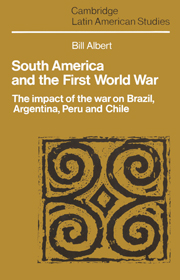Book contents
- Frontmatter
- Contents
- Tables
- Acknowledgments
- Introduction
- 1 Before the War
- 2 The early impact of the War
- 3 The recovery of trade during the War
- 4 Seeking financial solutions
- 5 The War and the growth of manufacturing industry
- 6 The War and the workers
- 7 After the War
- Notes
- Bibliography
- Index
- CAMBRIDGE LATIN AMERICAN STUDIES
6 - The War and the workers
Published online by Cambridge University Press: 22 October 2009
- Frontmatter
- Contents
- Tables
- Acknowledgments
- Introduction
- 1 Before the War
- 2 The early impact of the War
- 3 The recovery of trade during the War
- 4 Seeking financial solutions
- 5 The War and the growth of manufacturing industry
- 6 The War and the workers
- 7 After the War
- Notes
- Bibliography
- Index
- CAMBRIDGE LATIN AMERICAN STUDIES
Summary
Introduction
The development and spread of primary export-based capitalism in Latin America from the latter decades of the nineteenth century was characterized by many of the phenomena associated with the rise of industrial capitalism throughout the world, such as improved communications, a more up-to-date financial system, urbanization, industrial growth, and the extension of railway networks. These revolutionary changes in the material forces of production called forth an equally if not more revolutionary transformation in the relations of production. From the early to middle decades of the nineteenth century such a transformation had begun to take place in most Latin American countries. It should not, however, be imagined that this was simply a function of the supposed technological or market imperatives of industrial capitalism. It was a much more complex process. From Independence systems of servile labor in Latin America had been under attack from a number of quarters. The most potent force underlying all the various strands of the anti-slavery movement was the liberal ideology thrown up by the process of capitalist change taking place in Europe. This ideology not only influenced many Latin Americans, but also lay behind the vigorous and largely successful anti-slave trade policy of the British government. Slaves became more expensive, the systems decayed and alternatives had to be found. There was, however, great variation in the character and timing of change. In Peru slavery was abolished in 1856, but semi-servile Chinese coolie labor continued to be used on coastal plantations into the 1880s.
- Type
- Chapter
- Information
- South America and the First World WarThe Impact of the War on Brazil, Argentina, Peru and Chile, pp. 233 - 305Publisher: Cambridge University PressPrint publication year: 1988

